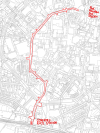P Binnersley
Member
- Joined
- 30 Dec 2018
- Messages
- 437
A planning application (PL/2024/0000288/FULM) has been submitted for the Coventry VLR (Very Light Rail) demonstration line.
The link gives access to all the documents submitted with the application, including scheme drawings and the "planning statement".
From the planning statement.
Don't expect to ride on it any time soon:
The link gives access to all the documents submitted with the application, including scheme drawings and the "planning statement".
Proposed City Demonstrator section of the Coventry Very Light Rail Project that includes installing new track, two temporary platform stops, a depot building and stabling area along with ancillary highways and junction works to facilitate the creation of a Very Light Rail vehicle testbed
The VLR route will extend some 1.5km through Coventry city centre from Warwick Road railway bridge, west of Coventry Railway Station, northwards to Millennium Place west of Pool Meadow Bus Station. The depot and stabling area for the CVLR test vehicle will be located just north of Eaton Road.
From the planning statement.
The document gives estimated completion dates "Early 2025" for phase 1 and "Q3 2025" for phase 2.The Scheme has been designed as a single scheme of approx. 1.5km of track but will be constructed in two phases (these phases relate to the release of funding):
Phase 1: Coventry Railway Station [Warwick Road] to Collection Centre (old Ikea building)[Queen Victoria Road]; and
Phase 2: Collection Centre to a point just west of the Pool Meadow Bus Station [Hales Street].
The battery-operated light weight vehicle, weighing around 11 tonnes unladen, would have capacity for approximately 56 passengers and requires no overhead infrastructure.
Don't expect to ride on it any time soon:
As noted above, the Scheme is purely to test that the concept of CVLR works. Therefore, it will likely run a limited, ad-hoc timetable and will not be for public use.

